Menstrie War Memorial
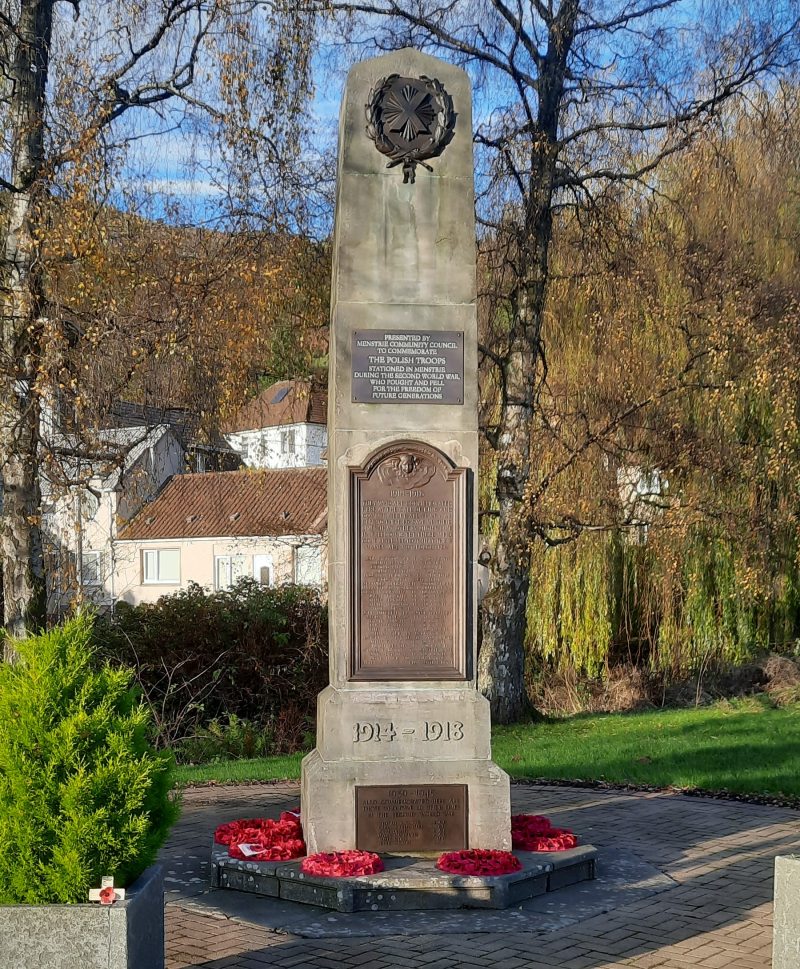
Menstrie's War Memorial now stands in Midtown Park, on the northern side of Menstrie Main Street. The Menstrie Burn runs along the west side of the park just beside the Memorial.
Prior to 1992 the Memorial had been on the southern side of the road approximately where the Dumyat Centre now sits. The Memorial should never need to be resited again as it is now on a protected space (See 'Fields In Trust' below).
The Memorial was designed by Mr Walter Fairbairn of Edinburgh, who had attended The School of Applied Art and Heriot Watt College. Walter won the Royal Institute of British Architects (RIBA) Tite Prize in 1901, a very prestigious award at the time.
Robert McGee was appointed as the Contractor for the Memorial, which was sculpted from Cullaloe Freestone from a quarry in St Andrews owned by Messrs J. & H. White.
Alexander Carrick, a well known Scottish sculptor, was commissioned to make the memorial. Alexander was a student at the College of Art in Edinburgh from 1897, he went on to win the Queen's Prize, a two year scholarship which allowed him to study at the South Kensington College (Now part of the Royal College of Art, London). During his time studying he was apprenticed to three notable sculptors, Birnie Rhind in Edinburgh, then under the French sculptor Professor Edouard Lanten whilst in London and finally Pittendrigh MacGillivray on his return to Edinburgh. He then worked on many well known buildings before World War I, including Edinburgh's Usher Hall, Eilean Donan Castle and St Magnus Cathedral in Kirkwall, Orkney.
The Memorial comprises of a square tapering obelisk which stands of a square plinth which itself stands on an octagonal base, When first unveiled the Memorial was surrounded by a ornamental railing made of iron and supplied by R. Mercer and Co., Iron founders in Alloa. Relatively unusually Menstrie's War Memorial have the men's names listed on the Memorial in date order of when they fell instead of alphabetically which the majority of other memorials have.
On the South facing side of the Memorial there are three bronze plaques and a bronze medallion surround by a laurel wreath sculpture at the top of the obelisk. The larger of the three plaques lists the names of Menstrie men who fell during World War I. At the base of the obelisk is a plaque which lists the name of the men who fell during World War II and finally there was a plaque added in 2016 which is dedicated to the Polish Men who were based in Menstrie before going into conflict.
Medallion

The medallion is made from bronze and consists of a laurel wreath which is traditionally associated with commemoration as well as symbolising the continuation of life and victory. Inside the wreath is a St Andrews Cross, which is to acknowledge that most of these men fought for Scotland at a time of great wars.
The Polish Plaque
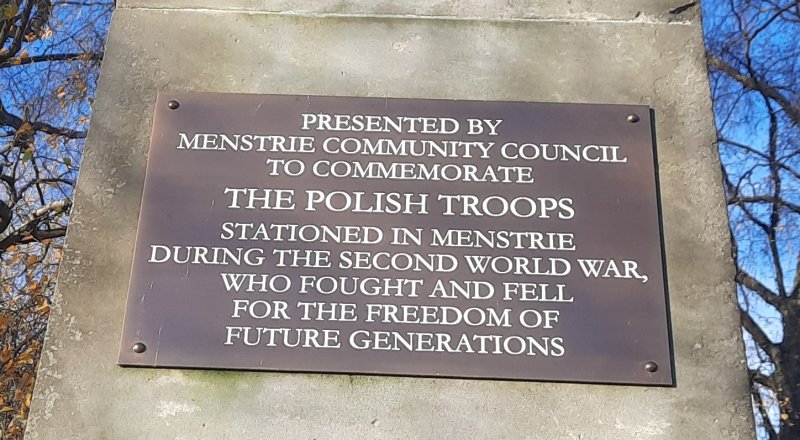
A bronze plaque was added in June 2016, which is dedicated to the Polish Soldiers who were based in Menstrie during World War II.
“Presented By
Menstrie Community Council
To commemorate
THE POLISH TROOPS
Stationed in Menstrie
During the Second World War,
Who fought and fell
For the freedom of
future generations”
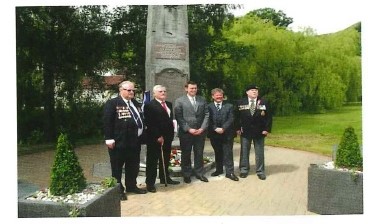
The plaque was designed by local Councillor Les Sharp, then procured and presented by Menstrie Community Council. The unveiling was attended by MSP Keith Brown, Deputy Polish Consul Tomasz Tadla, local Councillor Les Sharp as well as members of the Community Council and some villagers. There was an afternoon reception which was hosted at Menstrie Parish Church Hall, where many memories were shared.
These soldiers made friends within the community. Many locals called the arrival of the Polish Soldiers the “friendly invasion”. Menstrie Parish Church was the base for the 1st Battalion Polish Rifles. The polish men's presence was very much treated as a positive and their host town was friendly and welcoming, just as they were friendly and welcoming to the locals There were some life long friendships made between both nationalities. There were regularly social events, competitions for the children for which the visitors provided prizes. Children of Menstrie Primary School learnt the polish national anthem as well as some polish phrases. These men came to Britain after Hitler had invaded their home country. They trained and readied themselves and later fought bravely throughout Europe.
Prior to the unveiling of the Polish Memorial Plaque the Memorial had been restored thanks to Menstrie Community Council and funding from the Clackmannan and Stirling Environmental Trust allowed for the Memorial to be cleaned as well as chairs and planters to be added to the area surrounding it.
The First World War Plaque
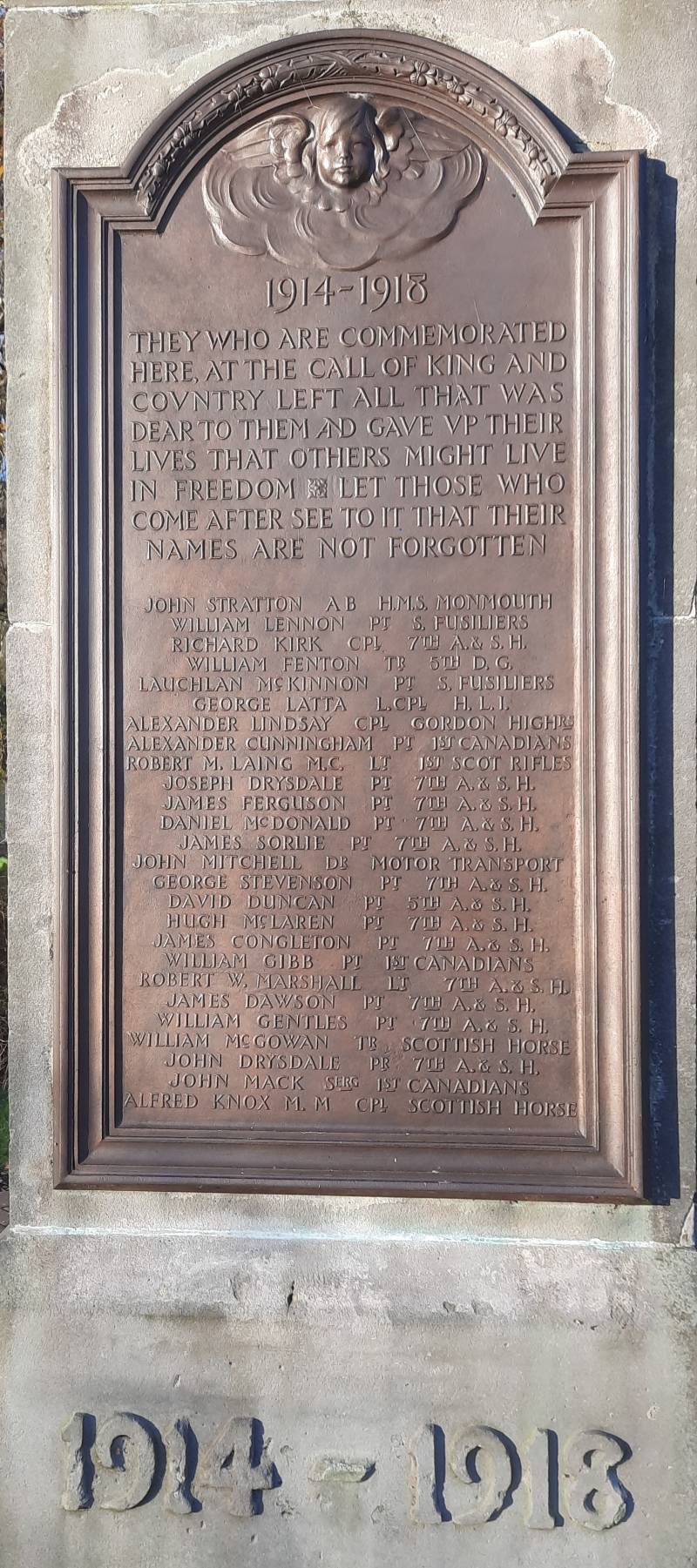
This plaque is again made of bronze and has the names of all local men who died whilst fighting in World War I.
“1914 – 1918
They who are commemorated here
at the call of the King and Country
left all that was dear to them
and gave up their lives that others may live in freedom.
Let those who come after see to it
that their names are not forgotten”
As can be seen a large number of the men were in the 7th Battalion of the Argyll and Sutherland Highlanders. The Battalion was the local Reservist Battalion and these men were some of the first to go overseas to fight. Sadly during world war one most men from single villages would sign up for military service in the same service and battalion as happened in Menstrie. This meant however that villages and town would have most military fit men away fighting and sadly in some cases a lot of these men died on the battlefield, leaving a huge gap in their villages.
The names will all be listed further on.
Second World War Plaque
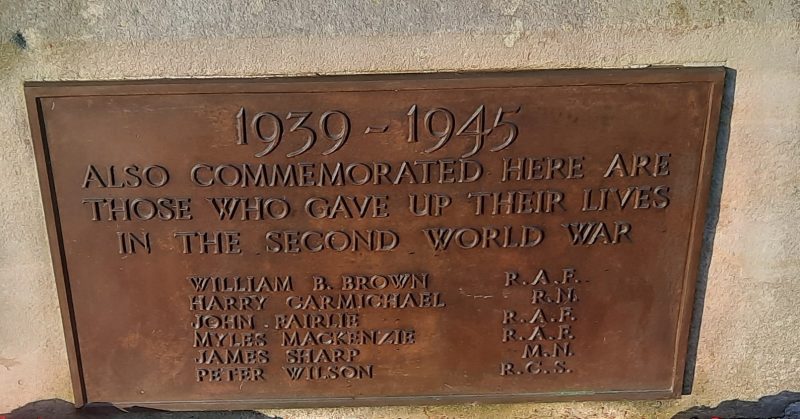
The Second World War plaque is again bronze this is placed on the lowest portion of the Memorial.
“1939 – 1945
Also Commemorated Here Are
Those Who Gave Up Their Lives
In The Second World War.”
The names will all be listed further on.
Field in Trust Plaque
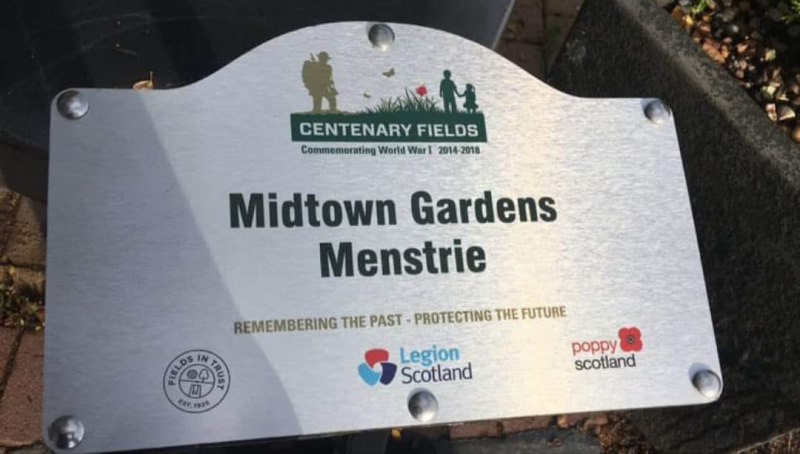
Menstrie's compassion and thoughtfulness of having the plaque for the Polish Soldiers on the War Memorial was acknowledged by The Fields in Trust Charity who bestowed not one but two honours on the village. The Midtown Park and War Memorial became a Centenary Field, which makes the area a protected park in perpetuity to honour the memory of the millions who gave their lives in the First World War. Very few war memorials have any acknowledgement for those men from other countries who had fought and died during the First World War.
The park also became a “Field in Trust” this means that a legal agreement has been made to preserve the space as a public park in perpetuity, this agreement is reached via a “Minute of Agreement” in Scotland between the landowner and the Field In Trust Charity. The local community, council and landowner manage the land within certain criteria always for the benefit of the community.
“Lone Tommy”
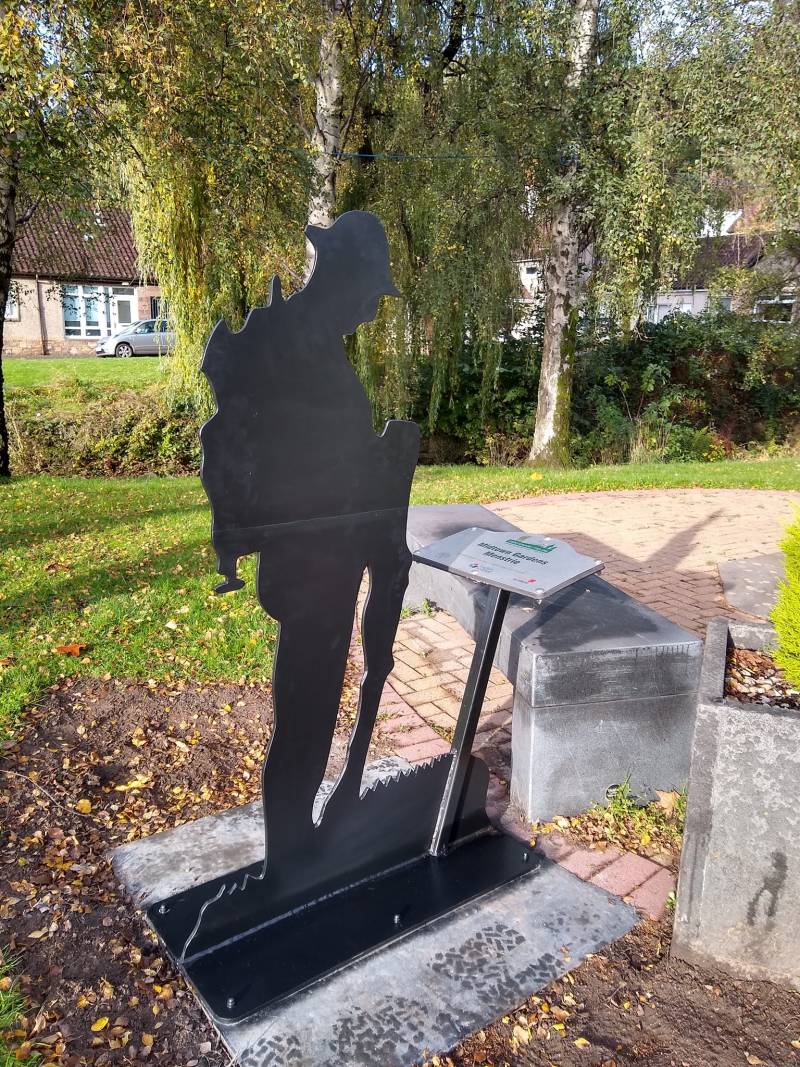
On the second of November 2021 the latest addition was added to the War Memorial Garden in Menstrie. The Menstrie Community Council had commissioned a “Lone Tommy” silhouette sculpture, which was designed, made and installed by G.M. Welding Services Artistic Ironworks Limited of Alloa.
The Menstrie “Lone Tommy” is designed slightly differently from most other variations of the “Tommy Silhouette Sculptures” in that this one is looking at the Plaque from the Fields In Trust Charity informing all that the War Memorial and Park are listed as a Field in Trust and a Centenary Park.
There area of soil around the “Lone Tommy” has had Poppy seeds planted and with a little time this will become a very eye catching poignant reminder of all soldiers killed in action for their country, the very reason we wear it every Remembrance Sunday.
Original Unveiling in 1922
Sadly there is very little information I have been able to source other than what I have presented above. However I did manage to source a newspaper report about the initial unveiling of the War Memorial, in its original site. This article below is from one of the local newspaper, I'm sorry I don't have the name of the newspaper or of the writer.
“Ideal weather favoured the unveiling ceremony and there was a very large gathering present from all parts of the district and County. A guard of honour of the 7th Battalion Argyll and Sutherland Highlanders, under Captain Philp, M.C. (Military Cross Awardee), was drawn up on either side of the path leading up to the Memorial. Seats were provided in front of the Memorial for relatives of the fallen men and the children of the Menstrie Public School were marshalled close by under the instruction of Mr R.G. Duff Headmaster and the teachers.
The praise was led by the combined choirs of the local Parish and United Free Churches, under the leadership of Mr Matthew McKenzie, and also by Alva's Town Band under the conductorship of Mr F.J. Mellow. Mr Charles Soter, Chairman of the Memorial Committee presided and was accompanied by Colonel Stein, Reverend John Boyd, B.D. Minister of the Parish, Reverend John McDonald, Minister of Menstrie and Blairlogie United Free Church and the members of the Memorial Committee.
When this party had taken up their positions at the base of the Memorial, the Alva Band played as a voluntary the well known hymn tune “Sandon” (Lead, Kindly Light”). The gathering then joined in singing the 124th Psalm (2nd Version) after which Rev. John Boyd offered a prayer.
Mr. Souter in introducing Col. Stein said the latter was a subaltern of the 7th Argyll & Sutherland Highlanders (A&S Highlanders), and that at the outbreak of hostilities he went out to the front along with the men of the Battalion, and during the war he worked with them, fought with them, and led them in the fighting and many of the names that were inscribed on the Memorial were names of men well known to him.
The Committee felt that as Col. Stein had had charge of their local Regiment in many of its battles, he was the most fit and appropriate person they could find to represent the fallen that day.
Col. Stein said he considered it a very great privilege to have been asked to take part in the ceremony and to join with them in paying homage to the men of their district, who fell in the Great War.
In the list of twenty six men from their small community who had made the supreme sacrifice, eighteen had served in the 7th A&S Highlanders, their County Territorial Regiment. The 7th Battalion was one of the earliest Territorial Battalions to go overseas. It crossed to France on the 15th December 1914 and took part in twelve very important battles throughout the war, and in every case distinguished itself. He thought it was only right that they should have a permanent memorial to these men in the Navy, Army and Air Force who fell in the war.
In most things our memories were short and while the present generation would not soon forget the debt they owed to the fallen, that Memorial would always be a reminder to them and to future generations of the enormous sacrifices made in the greatest of all wars. Looking back on the history of our country there might be occasions in the past where the righteousness of our cause might be doubted but in the case of the Great War it was more than ever clear that we could not have stood aside and he thought it was a great comfort to feel that while the price of victory had been appalling, we in this country had no alternative and we could have taken no other course.
War was a tremendous disgrace to civilisation. It was a hideous thing and had very little of the glamour that history had given to it in the past. Surely the time was due now when civilised nations could settle their disputes in future without bloodshed, by means of some Inter-nation Court of Justice among nations. It seemed the natural course of evolution that this should come and the fact that many of the civilised nations had experienced for themselves the horrors of war ought to hasten the day when the League of Nations would become a real live power in the world.
It seemed to him that while the people of this county were ripe for the League and supported it, we must keep in mind that many of the other peoples of the world had still got to be educated up to it. We would not be able to depend upon the League until the civilised nations including America were wholeheartedly in favour of it, and give it their wholehearted support. Continuing Col. Stein said this country had every reason to be proud of its record in the war. It was a gruelling test and brought out a fine spirit of comradeship which had proved of value in helping us to stick it out. There no doubt had been some reaction from that unselfish spirit since the end of the war.
He felt that if all classes could only pull together in peace in anything like the same spirit in which they had pulled together in the dark days of war, we would have in this country a more truly Christian people than in others and we would give the lead to the world in regaining prosperity.
The Ceremony that day brought back very vividly to them the memory of brave men whom they knew and loved. Life was very dear to everyone of them, but they unselfishly sacrificed it in the cause of justice and freedom. They had hoped to come back to their peaceful homes and the shadow of these quiet, peaceful hills again but they had no thought of shirking their duty and for them the path of duty was the way of glory. In unveiling that memorial, he hoped it would serve to keep their memories evergreen and that it would also serve to remind us of our duty to be worthy of their great sacrifice.
Col. Stein then unveiled the Memorial while the Guard came to the Salute, and Buglers Hunter and McQuire from Alva sounded the “Last Post”. Pipe Major R Ormiston, Stirling, Piper W. Fraser from Tillicoultry and Piper R. Dow, Stirling then played the lament “Flowers o' the Forest”. While this was being played relatives of the fallen men placed beautiful wreaths on the steps of the Memorial.
Mr Souter on behalf of the Memorial Committee, then tendered thanks to Col. Stein for his kindness in coming to unveil the Memorial and also for his kindly reference to their fallen friends. On behalf of the Community and the Memorial Committee, it was also his duty to ask the Landward Committee of the Parish to accept custody of the monument and to see that it was at all times treated with the honour and respect worthy of the great cause for which it was erected.
Mr Charles McGregor, in the name of the Landward Committee accepted custody of the Memorial and trusted that the members of that body would exercise every care in preserving it especially in memory of those men whose names were inscribed there on.
Rev. Mr McDonald then offered a prayer and the proceedings were brought to a close by singing the second Paraphrase, the pronouncing of the Benediction by Rev. John Boyd and the singing of the National Anthem.
World War One Fallen
John Stratton, Able Seaman, HMS Monmouth
William Lennon, Private, 1st Royal Scots Fusiliers
Richard Kirk, Corporal, 1st & 7th Argyll & Sutherland Highlander
William Fenton, Trooper, 5th Dragoon Guards
Lauchlan McKinnon, Private, 2nd Royal Scots Fusiliers
George Latta, Lance Corporal, 1st Highland Light Infantry
Alex Lindsay, Corporal, 8th Gordon Highlanders
Alex Cunningham, Private, 1st Canadian Infantry
Robert M. Laing, (Military Cross), Lieutenant, 4th Scottish Rifles
Joseph Drysdale, Private, 7th Argyll & Sutherland Highlander
James Ferguson, Private, 7th Argyll & Sutherland Highlander
Daniel MacDonald, Private, 7th Argyll & Sutherland Highlander
James Sorlie, Private, 7th Argyll & Sutherland Highlander
John Mitchell, Driver, Motor Transport
George Stevenson, Private, 7th Argyll & Sutherland Highlander
David Duncan, Private, 7th Argyll & Sutherland Highlander
Hugh McLaren, Private, 7th Argyll & Sutherland Highlander
James Congelton, Private, 7th Argyll & Sutherland Highlander
William Gibb, Private, 7th Canadian Infantry
Robert W Marshall, Lieutenant, 7th Argyll & Sutherland Highlander
James Dawson, Private, 7th Argyll & Sutherland Highlander
William Gentles, Private, 7th Argyll & Sutherland Highlander
William McGowan, Trooper, 13th Black Watch (Scots Horse)
John Drysdale, Private, 7th Argyll & Sutherland Highlander
John Mack, Sergeant, Canadians
Alfred Knox, (Military Medal) Corporal, 13th Black Watch (Scots Horse)
World War Two Fallen
William R Brown, Royal Air Force
Harry Carmicheal, Ordinary Telegraphist, HMS Isis, Royal Navy
John Fairlie, Leading Aircraftman, Royal Air Force
Myles MacKenzie, Sergeant, Wireless operator/Air Gunner, Royal Air Force
James Sharp, SS Empire Prairie, Merchant Navy
Peter Wilson, Signalman, Royal Corp of Signals
Who were the Fallen Men
The names on a memorial don't tell you about those who have died but each of them had a life before answering to the call of “duty” and serving their country during either WWI or WWII. Menstrie was not a large village when the first world war started, like many other villages and towns in the United Kingdom almost all men who were fit and between the ages of 18 and 41 had left their families and homes and marched off with men they had grown up with. These battalions were called “Pal Battalions” as many of the men came from the same areas. The fallen men were at times called the “Lost Generation” as some villages, towns etc. did not have any men in the 18 – 41 age bracket as unfortunately many of the village men didn't return from war.
Mr John & Mrs Jane Ann Drysdale
51 Long Row
Menstrie
Had four sons Joseph, John, David and Francis at the start of WWI, it is recorded that at least two of the men went off to fight for “King and Country”.
Prior to WWI Joseph was in the local territorial regiment for two years and worked for Distillers Company Ltd.
He signed up to the 1st/ 7th Argyll and Sutherland Highlanders. Joseph is known to have fought in the Battle of the Somme in France. Sadly he was Killed In Action on the 27th of July 1916. At this point the battle in this region of France was the battle of Delville Wood. This was a battle which lasted from the 15th of July until the 3rd of September. This battle took a large number of lives on both sides and Joseph was a relatively early fatality.
John Drysdale signed up to the 2nd battalion of the Argyll and Sutherland Highlanders. The division John was part of were attacking along the northern coast at Flanders and did not return it was initially unknown if he had been taken prisoner or not. Sadly it was later discovered he was killed in action on either the 24th or 25thth of August 1917.
Sadly with both boys being killed in action their parents would have the Postman's knock twice on her door with the military telegram every mother, father, girlfriend, wife etc. dreaded. During these times the how quickly the soldiers next of kin received the dreaded telegram varied largely, basically depending on how big the battle was and the number of deaths. Depending on how many of the remaining two brothers saw active service Mr & Mrs Drysdale would be fearful of more military telegrams. Some families lost all the male relatives of fighting age during WWI.
Mr & Mrs William Laing
Head Teacher
The School House
Menstrie Public School
Mr William & Mrs Mary Ann Laing's third son, Lieutenant Robert MacLeod Laing, was in the 16th Battalion Scots Rifles. Prior to the war Robert had attended Dollar Academy where he was well known for his sportsmanship. Robert played in the schools Cricket team for three years and was the Team Captain in 1910. He then went on to play for Clackmannanshire County. He was also well known as a musician locally. Prior to the war he was an apprentice Chartered Accountant training under Mr Philip C.A. Dunfermline.
Robert initially enlisted in Troon, Ayrshire in October 1914 as a Private in the Highland Light Infantry 17th Battalion. In March of 1915 Robert received a commission into the Scottish Rifles 4th Battalion. After a short time he became attached as Second Lieutenant to the Cameronians (Scottish Rifles) 1st Battalion in June 1915. He had been on active service at the front since this time.
Robert is one hero among many, he received the Military Cross medal after putting his life at risk getting information that later would be useful to the allies. Whilst he and three other men remained close to the German front line hiding they were also just a few yards from their own trenches. After approximately 17 hours, at dusk the men were spotted and shot at. After he reversed a short distance he “bombed” the Germans and he finally withdrew in to the dark. His medal was awarded for “Conspicuous Gallantry whilst on patrol duty”.
While leading a charge on “High Wood” During the ongoing Battle of the Somme Robert was positioned approximately in the mid section of the British frontline, from where he lead a charge of two platoons. Sadly he was killed in action when shot by a machine gun on the 20th of July 1916, aged 23.
Robert was the first officer to die from Menstrie.
Mr Myles & Mrs Mary MacKenzie
Menstrie
The MacKenzie's son Myles was the first Menstrie man to be killed in action in WW2. Myles was a Sergeant wireless operator and air gunner in the RAF based at Gura in Eritrea of North East Africa. He was a member of 45 Squadron who were performing anti-shipping, bombing and reconnaissance missions in support of allied ground forces against an Italian offensive into Sudan and Egypt.
On the 2nd of October 1940 Myles was in a Bristol Blenheim G, which was flying a three aircraft mission to attack Gura at dawn. However over Mai Edega six Italian CR.42 fighters planes engaged with the formation and attacked them. Myles was in the lead aircraft along with Squadron Leader John Dallamore and Pilot Officer A Sheppard. The CR.42's concentrated on Myles' aircraft, a Bristol Blenheim which rapidly caught fire. John Dallamore jettison his bombs. John Dallamore remained on board to keep the aircraft under control to allow both Sheppard and Myles to bail out, sadly John Dallamore ran out of time to bail out and the aircraft exploded on hitting the ground.
Pilot Officer Sheppard was taken Prisoner of War, Myles was found dead on the ground and was buried in Asmara War Cemetery, Eritrea.
I would like to take this opportunity to thank several people as well as acknowledge the documents I have used to help me compile this article.
Mr. Les Sharp, who has filled in quite a few blank spots for me and has already helped me with one of my next articles.
Menstrie Community Council, I have to acknowledge the community council's facebook page administrators and members who have all been so kind as to reply to my pleas for information. I have also used some photographs the Community Council have taken of the Field In Trust plaque as well as the “Lone Tommy”. Thank you all.
Mr Peter McNiven, who generously has allowed me to use his publication as a information resources as well as providing some of the photographs I have used. Thank you so very much.
“Menstrie War Memorial”, September 2023”
Ian Middleton, “Hillfoots Armed Forces Fatalies 1914- 1918”
https://ochils.org.uk/sites/default/files/oral-histories/docs/hillfootsarmedforcesfatalitiesreformatted20150519.pdf
Stirling Observer “Menstrie Recalls the Friendly Invasion” 22/06/2016
https://www.pressreader.com/uk/stirling-observer/20160622/281621009630416?fbclid=IwAR1bTq8B-x4g9mEyY6mLt_ANQsV6h99Y146h97XW2ac92efHya5ChQ94R6w
